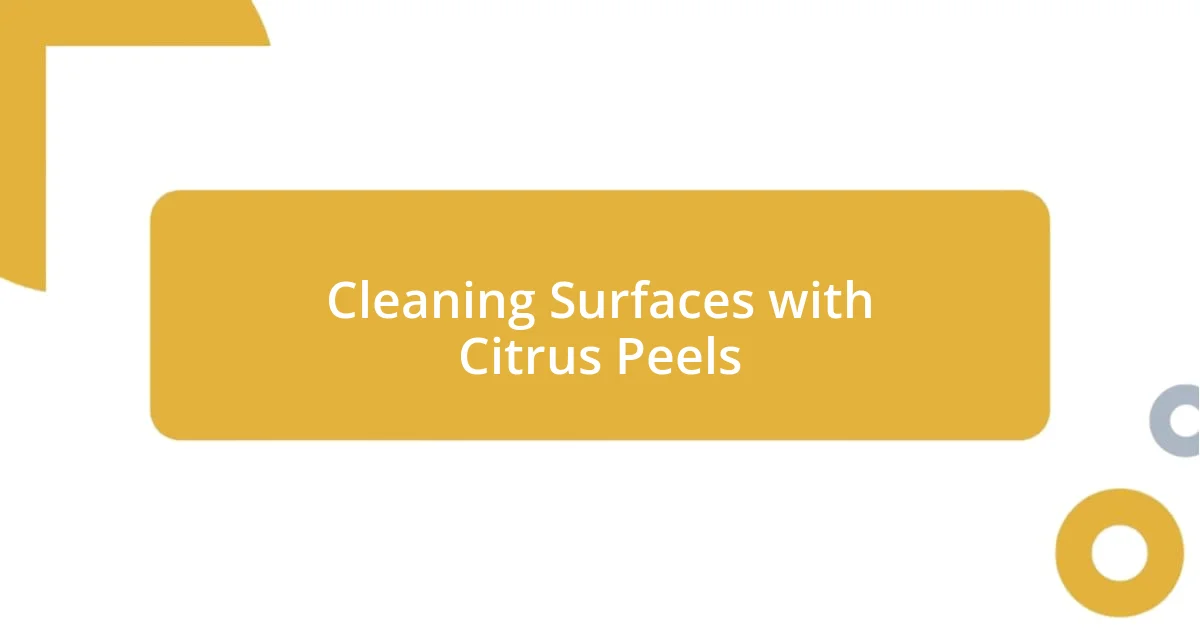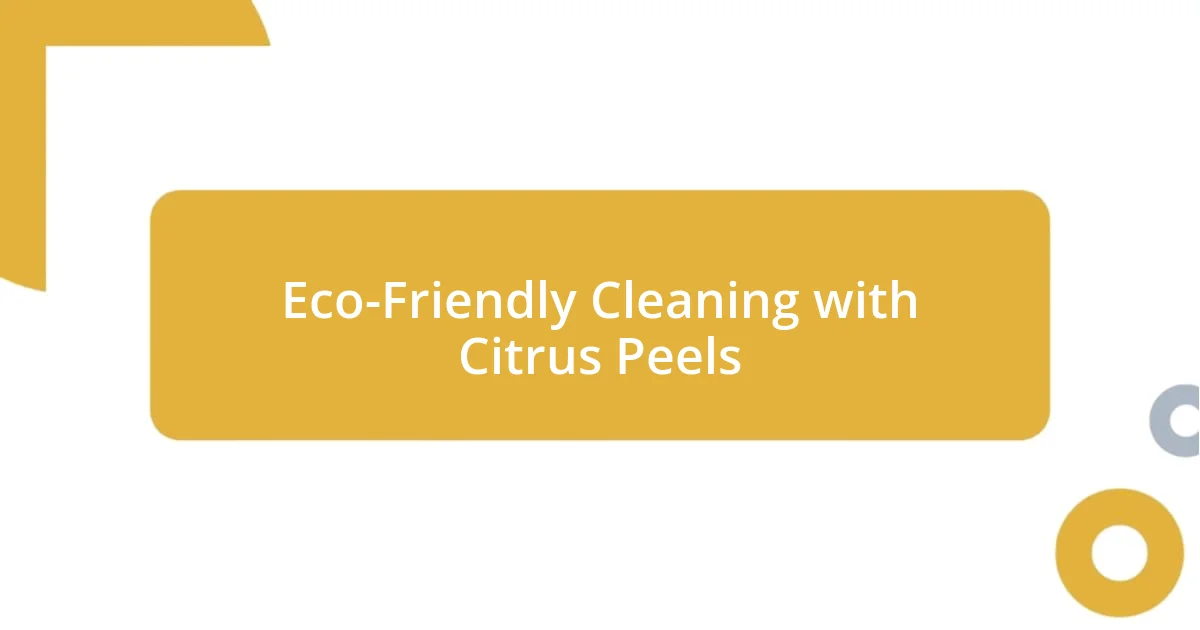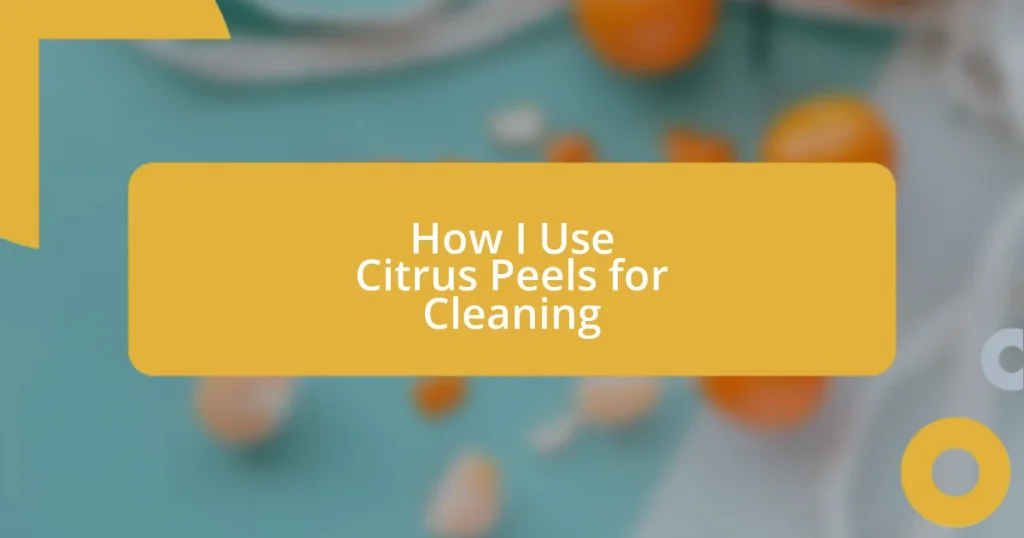Key takeaways:
- Citrus peels offer natural deodorizing properties and effectively break down grease, making them excellent for cleaning surfaces without harsh chemicals.
- Preparing citrus peels for cleaning involves washing, peeling, cutting, and drying them, enhancing their cleaning potency.
- Using and storing citrus peels in eco-friendly ways, such as freezing or infusing in vinegar, allows for sustainable cleaning choices while reducing waste.

Benefits of Using Citrus Peels
One of the most compelling benefits of using citrus peels for cleaning is their natural deodorizing power. I remember the first time I scrubbed my cutting board with orange peels; the fresh scent was invigorating! Instead of masking odors, the citrus oils actually neutralized them, leaving my kitchen smelling like a sunny day.
Additionally, citrus peels contain natural acids that effectively break down grease and grime. Have you ever struggled with sticky residue on your oven tray? I have, and using lemon peels made the task surprisingly easy. The oils not only cut through the mess but also left a lovely, fresh aroma that lingered long after I cleaned.
Then there’s the beauty of using something that would otherwise end up in the trash. Not only does utilizing citrus peels make for eco-friendly cleaning, but it also feels satisfying. I can’t help but feel a sense of accomplishment every time I put leftovers to good use, turning waste into a powerful cleaning ally. It’s this small yet impactful choice that brings a bit of joy to my cleaning routine.

Preparing Citrus Peels for Use
To prepare citrus peels for use in cleaning, I always start by properly washing the fruit. I find that pesticides or waxes often linger on the surface, so a simple rinse under running water works wonders. Once they’re clean, I use a knife or a peeler to remove the outer layer, making sure to keep the pith (the white part) to a minimum. This way, I’m maximizing the amount of essential oils while minimizing any bitterness that could affect my cleaning.
Here’s a quick checklist for prepping citrus peels:
- Wash citrus fruits thoroughly under running water.
- Use a vegetable peeler or knife to remove the peel, avoiding the bitter white pith.
- Cut the peels into manageable sizes, ideally small strips or pieces.
- Allow the peels to dry slightly before using them in your cleaning routine; this enhances the oil’s potency.
I remember the first time I saved my kitchen scraps instead of tossing them. It felt like a mini-revolution in my household! Each time I gathered those peels, I felt a little proud, knowing I was making a simple, sustainable choice. That feeling of resourcefulness has only grown stronger as I continue to find new ways to harness the power of these vibrant treasures.

Cleaning Surfaces with Citrus Peels
When it comes to cleaning surfaces, I have found that citrus peels can work wonders, particularly on stubborn stains. For instance, I once faced a pesky coffee ring on my wooden table. After rubbing the spot with a lemon peel, I was amazed to see it lift right off. The natural oils not only tackled the stain but left my table smelling fresh and inviting.
I often combine citrus peels with a bit of salt for extra scrubbing power. I remember tackling my microwave after a messy cooking session. A mixture of lemon peel and salt made that greasy interior sparkle again without any harsh chemicals. It’s incredible to think that something as simple as a fruit peel can give life back to home appliances.
There’s a real satisfaction that comes from using these peels, especially when saving money and reducing waste. Just last week, I had a friend over who noticed how clean my countertops looked. When I shared my secret of utilizing citrus peels, we both agreed that the benefits went beyond just cleaning; it’s an eco-conscious choice that adds a personal touch to everyday chores.
| Citrus Peel | Cleaning Benefit |
|---|---|
| Lemon Peels | Breaks down grease and grime effectively |
| Orange Peels | Neutralizes odors while freshening the air |

Making Citrus Peel Cleaners
When making citrus peel cleaners, I often start by infusing the peels in vinegar. I find that the acidity of vinegar, combined with the potent oils in the peels, creates a powerful natural cleaner. After just a week of letting the peels sit in a glass jar filled with vinegar, I have a delightful citrus scent to accompany its cleaning prowess.
One of my favorite results came from mixing orange peels with vinegar to create an all-purpose cleaner. As I poured it into a spray bottle, I felt a sense of excitement about tackling my cleaning tasks. Isn’t it fulfilling to know that I can get rid of tough grime without relying on harsh chemicals? I’ll often find myself spritzing it around the kitchen, enjoying not just the cleaning benefits, but the uplifting aroma that fills the air.
Another technique I use is blending peels with water and a bit of baking soda for a more abrasive paste. I still remember the satisfying sound of scrubbing my bathroom tiles while the blend worked its magic. The fizzing action of the baking soda captivated my attention, and I couldn’t help but think about how nature provides us with such effective solutions. Why buy expensive cleaners when the answer lies in our trash?

Tips for Storing Citrus Peels
One of the best tips I’ve discovered for storing citrus peels is to keep them in the fridge. When I do this, they stay fresh longer, which is essential since I like to use them in various cleaning projects throughout the week. Just tossing them in a container helps prevent them from drying out or developing that unsettling mold that no one wants to deal with!
Another practical approach is to freeze the peels if I can’t use them right away. I simply chop them up and pop them into ice cube trays with a bit of water. This method not only preserves their freshness but also gives me instant access to zesty ice cubes that elevate the cleaning power of my homemade solutions. Have you ever tried this? Trust me, it’s a handy trick that keeps cleaning projects fun and efficient!
Lastly, I find it helpful to label any storage bag or container I use in the freezer. Sometimes, I forget what I’ve stashed in there, and labels save me from that perplexing moment of trying to remember what those frozen peels are for. It may sound simple, but little organizational tips like this can make a world of difference in my cleaning routine. Why complicate things when a little foresight goes a long way?

Eco-Friendly Cleaning with Citrus Peels
Using citrus peels for cleaning has become a rewarding ritual in my home. I recall the first time I decided to mop the kitchen floor with a citrus-infused solution; the moment I saw the shine and inhaled the fresh scent, I felt like I had unlocked a secret only nature could offer. It makes me wonder: why haven’t more people embraced these simple, organic alternatives to conventional cleaning products?
One of the most surprising benefits of using citrus peels is their natural ability to cut through grease. I clearly remember using a lemon peel to wipe down my stovetop after a cooking marathon. The way the oils lifted the stubborn stains left me astonished and a bit proud. Have you felt that joy when an eco-friendly solution outperforms a chemical cleaner? It’s not just gratifying—it’s a reminder of the power of nature that we often overlook.
Moreover, adding citrus peels to homemade cleaning solutions enriches the experience beyond mere functionality; there’s an emotional element to it. I enjoy the comforting routine of saving peels throughout the week, knowing they will soon contribute to a cleaner, happier home. I can’t help but smile when I notice guests reacting positively to the refreshing aroma—it reinforces the idea that eco-friendly cleaning can be both effective and inviting. What’s more appealing than a sparkling clean home that smells delightful, all while being kind to the environment?















